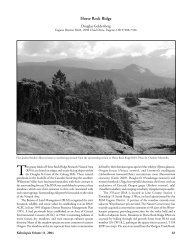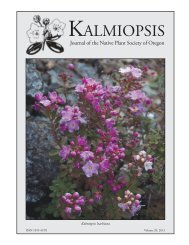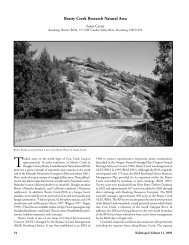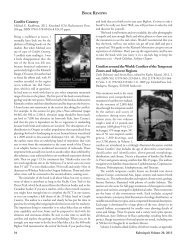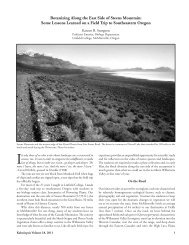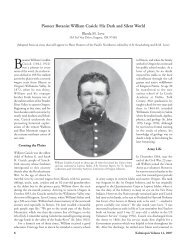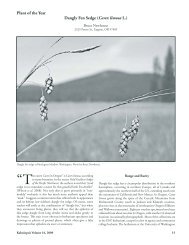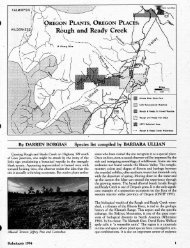Descriptive Key To Oregon Penstemons - Native Plant Society of ...
Descriptive Key To Oregon Penstemons - Native Plant Society of ...
Descriptive Key To Oregon Penstemons - Native Plant Society of ...
You also want an ePaper? Increase the reach of your titles
YUMPU automatically turns print PDFs into web optimized ePapers that Google loves.
Penstemon, with 271 species (mostly<br />
western) is the largest genus <strong>of</strong> flowering<br />
plants native solely to North<br />
America. <strong>Oregon</strong> ranks as fifth among<br />
the states in number <strong>of</strong> species, after<br />
Utah, California, Colorado and<br />
Nevada.<br />
<strong>Descriptive</strong> <strong>Key</strong> <strong>To</strong> <strong>Oregon</strong> <strong>Penstemons</strong><br />
This key covers the 46 Penstemon<br />
species native to <strong>Oregon</strong> (3 rare, 1 possibly<br />
a hybrid) and 2 species from other<br />
genera once included in Penstemon<br />
(Keckielia and Nothochelcrne). It is meant<br />
for the amateur botanist who uses a 10X<br />
magnifier and centimeter rule as aids,<br />
and cannot return weeks later for seed.<br />
P<br />
Ranges and subspecies given are for<br />
<strong>Oregon</strong>. Botany manuals should be used for verification (see<br />
references at end).<br />
General Description<br />
The corolla is the distinguishing feature <strong>of</strong> the genus. Bellshape<br />
or tubular with 5 lobes (2 above, 3 below), it has a nearunique<br />
pattern <strong>of</strong> 4 stamens (each with 2 anther sacs attached<br />
at the tip) and one sterile stamen (staminode), which is<br />
usually as long as the stamens and has a slight yellowish beard<br />
at the tip; sometimes it is exserted outside the corolla mouth.<br />
Such a staminode occurs in 7 other genera, worldwide: 2<br />
tropical, 5 (with 15 species) near relatives <strong>of</strong> Penstemon. (The<br />
relatives have stamens with hair at the base; penstemon<br />
stamens look bare at the base.)<br />
Corolla color is mainly shades <strong>of</strong> blue-purple or red-purple,<br />
rarely red, pale yellow or white (blue-purple species may have<br />
white or pink variants). In <strong>Oregon</strong>, the corolla is usually expanded<br />
abruptly, more or less widely, from a narrow tube;<br />
sometimes it is expanded gradually, slightly; sometimes it is<br />
pleated underneath. Outside, the corolla is - usually glabrous;<br />
usually it has a slight yellow or white beard, and <strong>of</strong>ten purplish<br />
guidelines, either within or on the lower lip.<br />
The corolla lobes are usually 1/4-1/5 as long as the corolla,<br />
with lower lobes slightly longer than upper ones. The 5 sepals,<br />
usually 1/3-1/4 as long as the corolla, are lanceolate or<br />
sometimes ovate, <strong>of</strong>ten slightly scarious. A long-exserted<br />
staminode may reach the end <strong>of</strong> the corolla lobes.<br />
Stem and inflorescence are usually leafy. The inflorescence<br />
is an indeterminate thyrse, usually <strong>of</strong> 2-5 nodes, with opposite<br />
cymes (usually determinate and 2-several flowered), or<br />
sometimes raceme-like. The inflorescence is usually at least<br />
slightly pubescent.<br />
<strong>Penstemons</strong> may be shrubs or herbs. Species that branch between<br />
base and inflorescence are shrubs (all woody) or subshrubs<br />
(with upper branches s<strong>of</strong>t and dying back); they have<br />
no basal leaves but <strong>of</strong>ten form mats. Most <strong>Oregon</strong> species (25)<br />
are perennial herbs (with stems s<strong>of</strong>t, not branching between<br />
By ROBIN LODEWICK<br />
base and inflorescence, and dying back<br />
to a branched woody base); they usually<br />
have basal leaves in a rosette, or tufted<br />
on short non-flowering stems.<br />
Leaves in most species vary in shape.<br />
Usually lowest leaves are borne on<br />
petioles, upper leaves are sessile. In<br />
herbs basal leaves are usually oblanceolate<br />
or obovate, lower stem leaves<br />
oblong, upper ones lanceolate or ovate.<br />
Usually leaves are glabrous, green (sometimes<br />
grey-green or blue-grey glaucous),<br />
and sharp-tipped. Leaves are opposite<br />
except in four species (all found in<br />
<strong>Oregon</strong>) where they may be alternate,<br />
or 1-4 at a node (see 26, deustus, 27,<br />
gairdneri, seorsus, 14, triphyllus).<br />
Classification in Penstemon is based mainly on the method<br />
<strong>of</strong> opening, shape, and pubescence <strong>of</strong> the anther sacs; to see<br />
fully open sacs, look at fading flowers. (Illus. shows sac shapes.)<br />
Use Of The <strong>Key</strong><br />
The actual key consists <strong>of</strong> the words in boldface, which form<br />
contrasting couplets (i.e., 02 Subshrub; 02 Herb). The rest<br />
<strong>of</strong> the description helps identify confusing species.<br />
A description given in the introduction, or at any level <strong>of</strong> the<br />
key, applies to all species below it unless a variation is stated.<br />
Such descriptions are not repeated unless necessary. For instance,<br />
"inflorescence usually pubescent" means that the statement<br />
is true <strong>of</strong> more than half the following species. Where<br />
a species does have a glabrous inflorescence, its description will<br />
say that (or, "herbage glabrous:' or "sometimes glabrous"). In<br />
subsection Proceri, however, where all herbage is usually<br />
glabrous, "inflorescence pubescent" is said when necessary.<br />
Note that some characteristics used in most keys are rarely<br />
mentioned here, because they are hard to see and not necessary<br />
for identification. These include pubescence on the stem,<br />
glandular (sticky or glistening) pubescence, and size <strong>of</strong> anther,<br />
seed, and capsule. (Anther sac and seed are usually less than<br />
1.5 mm long, large in subgenera Habroanrhus and Saccanthera.<br />
Seed is heavy, angular, ridged. Capsule splits at tip into four<br />
sections.)<br />
Regard "medium size" as usual. In this key, for leaves, medium<br />
length means between 30 mm and 100 mm long: medium<br />
width, 1/5-1/7 as wide as long. Medium size corollas are between<br />
15 mm and 25 mm long, from base <strong>of</strong> ovary to end <strong>of</strong><br />
lobes. Large or long, small or short, mean as compared to<br />
medium. (Most measurements are made on dried plants; living<br />
plants are <strong>of</strong>ten slightly larger.)<br />
And remember Murphy's Law for Botanists: any plant you<br />
choose to, examine is probably abnormal — simply because<br />
the human eye notices the unusual!<br />
12 Kalmiopsis 1994
Open partway:<br />
pubescent,<br />
with anthers<br />
exserted and<br />
lip bearded<br />
from inner end,<br />
bag-shape<br />
open all the way:<br />
COROLLA:<br />
inside view,<br />
with staminode<br />
exserted and<br />
bearded<br />
SEPALS:<br />
slightly scarious scarious erase<br />
ANTHER SACS:<br />
t•<br />
corolla<br />
front view,<br />
with guidelines<br />
unopen wooly, unopen<br />
wooly, open<br />
arrowhead-shape from outer end, S-shape,<br />
hairy horn-shape, with short hair<br />
with long hair<br />
//<br />
7/<br />
boat-shape explanate peltate-explanate<br />
Illustrations by Robin Lodewick<br />
Kalmiopsis 1994 13
01 Anther sacs wooly-pubescent (open end to end & across connective, but<br />
hidden in white fuzz)<br />
Leaves toothed (in 2 species, sometimes entire) Corolla usually large, expanded<br />
gradually, pleated underneath, with mouth slightly closed; lobes <strong>of</strong>ten small,<br />
projecting; no guidelines •<br />
(P Subgenus DASANTHERA & Genus NOTHOCHELONE)<br />
02 Subshrub, less than 40 cm tall ( 2 species, less than 10 cm)<br />
Cyme to 1 cm long, 1-flowered (in 1 species, 1-2 flowered)<br />
Leaves thick, broad (in 1 species sometimes narrow); upper stem leaves<br />
reduced<br />
Staminode 1/2 length <strong>of</strong> stamens (Subgenus DASANTHERA)<br />
03 Inflorescence <strong>of</strong>ten long, 4-8 nodes<br />
Leaves elliptic, to 40 mm long & 2/5 as wide<br />
Corolla rose-pink, 27-33 mm long<br />
Anther sacs show as white spots in mouth<br />
s Josephine Co. (as P carclwellii hybrid?) NEWBERRYI var. berryi<br />
03 Inflorescence short, 1-3 nodes<br />
04 Leaves blue-glaucous, ovate at least above<br />
Sepals ovate<br />
05 Cyme 1-2 flowered; inflorescence glabrous; lower leaves obovate, to 80<br />
mm long & 1/3 as wide; upper leaves to 35 mm & 2/3 as wide.<br />
Calyx 5-7 mm long<br />
Corolla pale red-purple, 25-38 mm long<br />
Staminode not bearded<br />
Columbia Gorge cliffs in Hood River & Wasco counties (RARE)<br />
BARRETTIAE<br />
05 Cyme 1-flowered<br />
Leaves small, blunt, to 20 mm long & 2/3 as wide<br />
<strong>Plant</strong> to 10 cm tall<br />
Corolla rose-red, 25-36 mm long; not bearded<br />
Staminode sometimes not bearded -<br />
high Cascade Range & Columbia Gorge RUPICOLA<br />
04 Leaves green, not glaucous<br />
Corolla blue-lavender or blue-purple (rarely, pale red-purple<br />
06 Leaves elliptic, medium size, usually 1/3-1/4 as wide as long<br />
Corolla 25-40 mm long<br />
07 Leaves just below inflorescence broat at base; lower leaves to 40 mm<br />
long<br />
w Side <strong>of</strong> Cascade Range, Coast Range; sw OR CARDWELII<br />
07 Leaves just below inflorescence taper to base; lower leaves to 60 mm<br />
long (sometimes varying to narrow, 1/4-1/7 as wide as long); leaves<br />
sometimes entire<br />
Inflorescence <strong>of</strong>ten one-sided<br />
e side <strong>of</strong> Cascade Range, c OR to n & e OR<br />
FRUTICOSUS var fruticosus<br />
06 Leaves ovate, small<br />
08 Leaves strongly toothed, to 25 mm long & 1/2-2/3 as wide<br />
<strong>Plant</strong> to 20 cm tall<br />
Corolla 30-40 mm long<br />
e Wallowa Co. FRUTICOSUS var. serratus<br />
08 Leaves entire (in <strong>Oregon</strong>, except hybrids), to 20 mm long & 1/2-2/3 as<br />
wide<br />
<strong>Plant</strong> to 10 (rarely 15) cm tall DAVIDSONII<br />
08a Corolla 34-45 trim long<br />
Steens Mtn. DAVIDSONII var. trraeteritus<br />
08a Corolla 20-36 mm long<br />
Leaves usually blunt (hybrids in Marion Co. toothed)<br />
high Cascade Range DAVIDSONII var. davidsonii<br />
02 Herb, 30-80 cm tall, usually growing in woods<br />
Cyme 1-3 cm long, 1-4 flowered, spreading away from stem<br />
Leaves all on petiole, to 110 mm long & 1/3 as wide; no basal leaves<br />
Corolla pubescent, pale or deep red-purple, 25-35 mm long; not bearded<br />
Stamens & staminode hairy at base; staminode bearded most <strong>of</strong> its length<br />
w side <strong>of</strong> Cascade Range; Coast Range NOTHOCHELONE NEMOROSA<br />
P rupicolcz<br />
14 Kalmiopsis 1994
01 Anther sacs glabrous, or (in 6 <strong>Oregon</strong> species) slightly hairy-pubescent<br />
09 Anther sacs open partway, narrowly, remaining closed at one end; sacs<br />
toothed along edge <strong>of</strong> opening<br />
Corolla expanded abruptly, widely (except in 1 species), <strong>of</strong>ten large (in 4<br />
species sometimes small); usually not bearded<br />
10 Anther sacs open partway from inner end, across connective; outer ends<br />
remain closed (saddlebag or arrowhead shape); hairy-pubescent in 5 species<br />
(See also 40, globosus, 44, euglaucus)<br />
Cyme usually 1-3 cm long, 1-3 flowered, sometimes longer and many-flowered<br />
(P. Subgenus SACCANTHERA)<br />
11 Leaves toothed (in 3 species sometimes entire)<br />
12 Subshrub, between 20 & 80 cm tall<br />
13 Leaves narrow to base, or most leaves on petiole<br />
Corolla pubescent; rarely, lip bearded<br />
Staminode moderately exserted<br />
14 Upper leaves not all opposite, 1-4 at node, <strong>of</strong>ten narrow, rarely entire,<br />
to 50 mm long & 1/5-1/8 as wide; lower leaves 1/2 as wide<br />
Cymes 1-3 at a node, 1-5 flowered (sometimes to 8 cm long &<br />
15-flowered)<br />
Corolla expanded gradually, slightly, sometimes small, blue-lavender to<br />
violet, 13-19 mm long<br />
ne OR TRIPHYLLUS<br />
14 Leaves opposite<br />
Corolla pale or bright red-purple<br />
Cyme 1-2 flowered RICHARDSONII<br />
14a Corolla 22.32 mm long<br />
Staminode bearded 1/2 its length<br />
14b Leaves deeply toothed, to 80 mm long & 113-1/5 as wide<br />
c OR to north, Columbia Gorge, ne OR<br />
RICHARDSONII var. richardsonii<br />
14b Leaves moderately toothed, <strong>of</strong>ten grey-pubescent, to 50 mm long &<br />
1/2 as wide<br />
c & nc OR RICHARDSONII var. dentatus<br />
14a Corolla 15.20 mm long<br />
Staminode not bearded<br />
Leaves usually like var. dentatus<br />
Wheeler & Wasco counties RICHARDSONII var. curtiflorus<br />
13 Upper leaves rounded at base, sessile<br />
Corolla usually with no guidelines<br />
Inflorescence glabrous, or essentially so<br />
Sepals <strong>of</strong>ten scarious erose<br />
15 Stamen-filament hairy just below anthers (only Penstemon like this)<br />
Cyme rarely to 8 cm long & 5-flowered<br />
Leaves long, <strong>of</strong>ten entire, to 120 mm long & 1/4 as wide<br />
Calyx 3-7 mm long<br />
Corolla bright red-purple, sometimes blue-violet, 25-38 mm long; lobes<br />
ciliate-edged<br />
ne OR<br />
- VENUSTUS<br />
15 Stamen-filament glabrous<br />
Cyme 2-5 flowered (rarely to 6 cm long & 10-flowered)<br />
Leaves very broad, coarse-toothed, to 90 mm long & 1/2 as wide<br />
Calyx 5-11 mm long; sepals sometimes broad-scarious & deeply erose<br />
Corolla blue-purple, sometimes red-purple, 16-28 mm long<br />
Coast Range & w side <strong>of</strong> Cascade Range, from Lane Co. north<br />
• SERRULATUS<br />
12 Herb, 40-100 cm tall<br />
Herbage all sticky-pubescent<br />
Leaves very long; basal leaves to 350 mm long & 1/4 as wide; upper leaves<br />
to 120 mm & 1/2 as wide<br />
Cyme 1-2 cm long; 2-4 flowered<br />
Corolla pubescent, dull lavender-purple, 28-40 mm long; rarely bearded<br />
Staminode not bearded, long-exserted GLANDULOSUS<br />
Kalmiopsis 1994 15
12a Leaves strongly toothed<br />
ne OR GLANDULOSUS var. glandulosus<br />
12a Leaves entire, or nearly so<br />
n Hood River & Wasco counties GLANDULOSUS var. chelarlen_sis<br />
11 Leaves entire (see also 12, glandulosus, 14, triphyllus, 15, venustus)<br />
Subshrub, mainly between 20 & 50 cm tall<br />
Corolla shades <strong>of</strong> blue-purple (rarely, red-purple or pink); pale or white<br />
guidelines show as 2 dots at lip; bud <strong>of</strong>ten yellow<br />
Inflorescence bare-looking, with long intemodes (except in 2 species)<br />
Staminode usually not bearded<br />
16 Corolla with lip bearded, 13.20 mm long<br />
Staminode bearded<br />
Leaves to 100 mm long & 1/8-1/10 as wide, <strong>of</strong>ten arched, folded ; grasslike<br />
<strong>Plant</strong> to 70 cm tall<br />
Cyme sometimes to 5 cm long & 7-flowered<br />
s Lake Co. GRACILENTUS<br />
16 Corolla lip not bearded<br />
Anther sacs hairy at inner end (in 15 species) or glabrous (in 1 species)<br />
17 Herbage glabrous, blue-glaucous<br />
Upper leaves very broad, 112 as wide as long; lower leaves 114 as wide<br />
Calyx 3-6 mm long<br />
Staminode rarely slightly bearded<br />
18 Corolla 20-30 mm long<br />
Leaves to 60 mm long<br />
sw OR AZUREUS var. azureus<br />
18 Corolla 14-20 mm long<br />
Leaves <strong>of</strong>ten short, to 35 mm long<br />
(<strong>Plant</strong> to 35 cm tall<br />
sw OR PARVULUS<br />
17 Herbage pubescent, grey-green or grey<br />
Leaves medium width or narrow, 1/6-1/10 as wide as long<br />
19 Corolla pubescent<br />
20 Herbage densely grey-pubescent<br />
Anther sacs glabrous<br />
Inflorescence leafy<br />
Corolla purple or blue-purple, 15-22 mm long<br />
Leaves to 50 (sometimes 80) mm long, <strong>of</strong>ten folded, arched<br />
s Malheur Co. ' KING!!<br />
20 Herbage moderately pubescent, grey-green<br />
Corolla blue-violet with blue lobes<br />
21 Anther sacs narrow at top, arrow-shape<br />
Corolla 20-30 mm long<br />
Leaves to 70 mm long, 1/8 as wide as long<br />
sw OR LAETUS var. sagittatus<br />
21 Anther sacs broad at top, saddlebag-shape<br />
Corolla 14-24 mm long<br />
Leaves to 70 mm long, 1/6 as wide as long<br />
Wheeler Co. south to sw OR ROEZLII<br />
19 Corolla glabrous, blue-violet or pink-lavender, 15-25 mm long<br />
Inflorescence leafy; cyme sometimes to 4 cm long & 5-flowered<br />
Herbage slightly pubescent, grey-green<br />
Leaves to 70 mm lung, <strong>of</strong>ten not quite opposite<br />
Sepals sometimes slightly erose<br />
Baker Co. to e & se OR CUSICKII<br />
10 Anther sacs open partway from outer end; inner ends remain closed, or<br />
rarely open narrowly across connective (horn-shape); sacs hairy-pubescent in<br />
1 species<br />
Corolla bright blue, slightly narrowed at mouth; lobes spreading; no<br />
guidelines<br />
Leaves entire, thick, firm; basal leaves very long, <strong>of</strong>ten narrow; upper leaves<br />
long or broad<br />
Inflorescence <strong>of</strong>ten long; cyme 1-2 cm long, mainly 2-4 flowered<br />
(P. Subgenus HABROANTHUS)<br />
16 Kalmiopsis 1994
22 Upper leaves very broad, 1/2 as wide as long<br />
23 Anther sacs pubescent with short stiff hair, S-shape<br />
Basal leaves to 250 mm long & 1/7 as wide; upper leaves to 90 mm<br />
Corolla 25-35 mm long<br />
<strong>Plant</strong> 20-60 cm tall<br />
Staminode bearded<br />
n Wallowa Co. PENNELLIANUS<br />
23 Anther sacs glabrous, straight<br />
Basal leaves to 160 mm long & 1/4-1/6 as wide; upper leaves to 70 mm<br />
Calyx 5-6 mm long<br />
Corolla 18-28 mm long<br />
<strong>Plant</strong> 10-70 cm tall<br />
Staminode sometimes bearded<br />
Wallowa Mtns. PAYE I I ENSIS<br />
22 Upper leaves medium width or narrow, to 100 mm long & 1/5-1/8 as<br />
wide; basal leaves to 150 mm & 1/7 as wide<br />
Anther sacs glabrous, S-shape<br />
Corolla 25-38 mm long<br />
Calyx 4-8 mm long (rarely to 13 mm); sepals slightly scarious erase,<br />
sometimes with long narrow tip<br />
Herbage sometimes grey-pubescent<br />
<strong>Plant</strong> sometimes very short, 5.90 cm tall<br />
Staminode rarely bearded<br />
e <strong>of</strong> Cascade Rang to e & s OR SPECIOSUS<br />
09 Anther sacs open all the way end to end & across connective, narrowly<br />
(boat-shape) or becoming flat (explanate) (except in 40, globosus, 44, euglaucus)<br />
(P Subgenus PENSTEMON & Genus KECKIELLA)<br />
24 Shrub or subshrub<br />
Corolla pubescent<br />
Leaves in 3 species sometimes not opposite<br />
25 Corolla pale yellow or white, usually small; usually with dark guidelines<br />
Leaves toothed (in 1 species sometimes entire)<br />
26 Shrub, with stems bare-looking, 15-150 cm tall<br />
Corolla pale yellow, expanded widely to gaping mouth, 10-14 mm long;<br />
upper lobes hooded, tinged brown, lower lobes reflexed; not bearded<br />
Leaves ovate, very broad, to 60 mm long & 1/2-1/3 as wide<br />
Cyme 3-4 cm long, 1-4 flowered (sometimes longer & many-flowered)<br />
Calyx 4-7 mm long<br />
Stamens & staminode hairy at base; staminode dense-bearded 1/2 its<br />
length ,long-exserted<br />
s Jackson Co. (RARE) KECKIELLA LEMMONII<br />
26 Subshrub, with stems usually leafy, mainly 20-60 cm tall (sometimes,<br />
as in se OR, bare-looking with few leaves)<br />
Corolla white or pale yellow, <strong>of</strong>ten tinged brown or lavender, glistening<br />
within, usually expanded gradually, slightly; upper lobes very small, lower<br />
lobes spreading<br />
Cyme short, to 1 cm long & 1.4 flowered (rarely longer & 5-8 flowered);<br />
inflorescence long, narrow, <strong>of</strong> 3-9 clusters<br />
Leaves <strong>of</strong>ten leathery, varying on different plants, either lanceolate or<br />
ovate; lower leaves sometimes obovate, blunt<br />
Calyx 2.6 cm long<br />
A variable species DEUSTUS<br />
26a Staminode densely bearded<br />
Corolla 8-10 (rarely 12) mm long; guidelines sometimes deep purple,<br />
crowded<br />
Leaves either lanceolate, coarse-toothed, sharp-tipped, to 60 mm long &<br />
1/3-1/4 as wide, or ovate, nearly entire, <strong>of</strong>ten blunt, to 30 mm & 1/2-1/3<br />
as wide<br />
<strong>Plant</strong> very woody at base<br />
sw OR DEUSTUS var. suffrutescens<br />
26a Staminode not, or only slightly, bearded<br />
Corolla more than 10 mm long<br />
Kalmiopsis 1994 17
26b Leaves strongly toothed, opposite, mainly broad, lanceolate, mainly<br />
to 60 mm long & 1/4-1/6 as wide, or ovate, to 40 mm & 112-1/4 as<br />
- wide<br />
26c Corolla with upper lobes pale yellow or white, 12-18 mm long (in<br />
ne Or, corolla <strong>of</strong>ten pure white with no guidelines)<br />
Leaves coarse-toothed (sometimes narrow,<br />
P deustits<br />
- to 75 mm long (Si. 1/7 as<br />
wide)<br />
w & e slopes <strong>of</strong> Cascade Range; ec & ne OR DEUSTUS var. deusnts<br />
26c Corolla with upper lobes tinged brown, 10-15 mm long from c OR<br />
south, corolla only slightly glistening)<br />
Leaves fine-toothed<br />
<strong>Plant</strong> usually not over 40 cm tall<br />
Deschutes Co. to s & se OR DEUSTUS var. pediceIlacus<br />
26b Leaves slightly toothed at outer end, or entire; [eaves usually not<br />
all opposite, 1-4 at node, narrow, to 50 mm long & 1/7-1/10 as wide<br />
Cymes 1-3 at node, 2-5 flowered; inflorescence short<br />
Corolla 10-15 mm long<br />
Staminode sometimes not bearded<br />
c & nc OR • DEUSTUS var. variabilis<br />
25 Corolla pink-lavender or blue-violet, narrow, 13-23 mm long; sometimes<br />
no guidelines<br />
Leaves entire, linear, sometimes not opposite, <strong>of</strong>ten crowded & heathlike<br />
<strong>Plant</strong> between 10 & 40 cm tall, matforming<br />
Herbage grey-pubescent<br />
Cymes short, 1 cm long, 1-2 at a node, 1-2 flowered<br />
Staminode with short beard most <strong>of</strong> its length<br />
27 Corolla with lobes large (1/3 length <strong>of</strong> corolla), spreading; beard slight<br />
GAIRDNERI<br />
27a Leaves alternate, 1 to a node, <strong>of</strong>ten small, to 35 mm long & 1/10 as<br />
wide<br />
Usually 1 cyme to a node<br />
Crook Co. to north; se OR GAIRDNERI var. gairdneri<br />
27a Leaves sometimes not opposite, to 50 mm long & 1/15 as wide<br />
ne OR GAIRDNERI var. oreganus<br />
27 Corolla with lobes medium size (1/4 length <strong>of</strong> corolla), <strong>of</strong>ten projecting<br />
Leaves sometimes not opposite, to 50 mm long & 1/15 as wide<br />
s Harney & Jefferson counties- SEORSUS<br />
24 Herb, with basal leaves <strong>of</strong>ten tufted (in 2 species, no basal leaves)<br />
28 Staminode with long, dense, golden beard most <strong>of</strong> its length, usually<br />
long-exserted (in 2 <strong>Oregon</strong> var. sometimes not exserted)<br />
Corolla pubescent; lower lobes reflexed<br />
Inflorescence dense; cyme 1-2 cm long, 2-6 flowered<br />
Herbage mainly grey-pubescent . -<br />
Leaves toothed at least near tip; or entire (P section AURATOR)<br />
29 Corolla with long narrow tube (at least 1/3 <strong>of</strong> corolla length), deeply<br />
.2-lipped, dull purple or blue-violet<br />
Basal leaves to 60 mm long & 1/4 as wide; upper leaves to 40 mm &<br />
1/5-1/6 as wide<br />
30 Staminode tip coiled<br />
Corolla sometimes large, 18-28 mm long; tube & lips each 2/5 <strong>of</strong> corolla<br />
length<br />
<strong>Plant</strong> 8-25 cm tall<br />
s Harney Co.<br />
JANISHIAE P janishiae<br />
30 Staminode tip straight, moderately exserted<br />
Corolla 14-22 mm long; tube & lips each 1/3 <strong>of</strong> corolla length<br />
<strong>Plant</strong> 10-40 cm tall<br />
Baker & n Malheur counties MISER<br />
29 Corolla with short broad tube (115 <strong>of</strong> corolla length)<br />
Basal leaves long, to 120 mm long, with upper leaves to 70 mm; leaves<br />
usually all 'narrow, 1/7-1/10 as wide as long (sometimes vary to all broad,,<br />
1/4 as wide)<br />
Calyx 6-13 mm long; lobes narrow<br />
<strong>Plant</strong> 10-40 cm tall<br />
(Staminode Long-exserted, except in OR) ERIANTHERUS<br />
18 Kalmiopsis 1994
29a Anther sacs 2/3-1/2 as wide as long, wide at connective<br />
Corolla sometimes large, pink-lavender to violet, 15-27 mm long<br />
Staminode sometimes not exserted; tip coils •<br />
e Wallowa Co. ERIANTHERUS var. redactus<br />
29a Anther sacs 1/2-2/5 as wide as long, narrow at connective<br />
Corolla red-purple to blue-purple, 18.23 mm long<br />
Staminode-with slight beard 112 its length, tuft at tip, not exserted<br />
nc OR ERIANTHERUS var. argillosus<br />
28 Staminode with pale yellow or white beard at least at tip, or sometimes<br />
not bearded (see also 29, el-jam/lents)<br />
31 Leaves toothed (or, in 3 species, sometimes entire); basal leaves long, on<br />
long petiole<br />
Cyme sometimes long & many-flowered<br />
Stem in 1 species <strong>of</strong>ten bare-looking<br />
Corolla pubescent, sometimes large (in 2 species) or small (in 4 species)<br />
(mainly P section HUMILES)<br />
32 Cyme spreading away from stem, 2-5 cm long, 2-7 flowered<br />
(sometimes longer, to -10 cm & 20-flowered)<br />
Leaves altogether ttiothed, mainly lanceolate; upper leaves broad, 1/3-1/4<br />
as wide as long<br />
Corolla expanded abruptly, widely, with lobes large<br />
<strong>Plant</strong> 30-100 cm tall<br />
33 Staminode long-exserted<br />
Leaves coarse-toothed; basal leaves tapered to petiole, 1/5 as wide as<br />
long<br />
Corolla pale or deep red-purple; lower lobes projecting, long<br />
34 Corolla usually large, 24-30 mm long<br />
Basal leaves very long, to 250 mm long, upper leaves to 90 mm<br />
Cyme sometimes long<br />
<strong>Plant</strong> 30.120 cm tall<br />
Staminode with tuft <strong>of</strong> long hair at tip<br />
Coast Range & w side Cascade Range, from c OR south<br />
• RATTAN!! var. rattanii<br />
34 Corolla sometimes small, 13.18 mm long, sometimes not bearded<br />
Basal leaves to 150 mm long, upper leaves to 60 mm<br />
Cyme <strong>of</strong>ten long<br />
<strong>Plant</strong> 20-90 cm tall<br />
Staminode sometimes not bearded<br />
Crater Lake to sw OR ANGUINEUS<br />
33 Staminode not (or only slightly) exserted<br />
Basal leaves narrowed abruptly to petiole, <strong>of</strong>ten ovate, sometimes blunt,<br />
to 150 mm long & 1/3 as wide; upper leaves to 100 mm<br />
Corolla blue or blue-purple, sometimes small, 15-23 mm long<br />
Calyx 3-5 mm long<br />
<strong>Plant</strong> 30-100 cm tall<br />
35 Leaves coarse-toothed, pubescent<br />
Cyme sometimes long<br />
Multnomah Co. OVAT US<br />
35 Leaves usually fine-toothed (rarely coarse toothed or entire), usually<br />
glabrous<br />
Cyme <strong>of</strong>ten long<br />
ne OR WILCOXII<br />
32 Cyme held close to stem, 1.3 cm long, 2-4 flowered<br />
Leaves toothed at outer end, or sometimes entire, moderately broad to<br />
narrow<br />
Sepals sometimes scarious erose<br />
Corolla expanded gradually moderately -<br />
36 <strong>Plant</strong> 30-80 cm tall, stem & inflorescence <strong>of</strong>ten bare-looking-with<br />
long intemodes<br />
Basal leaves very long, to 200 mm long & 1/7 as wide; upper leaves to<br />
60 mm & 1/4 as wide<br />
Cyme rarely to 6 cm long & 10-flowered<br />
Corolla <strong>of</strong>ten small, blue to blue-purple, 11-18 mm long<br />
n Hood River Co. SUBSERRATUS<br />
P rattanii<br />
Kalmiopsis 1994 19
36 <strong>Plant</strong> 10-30 cm tall<br />
Basal leaves to 100 mm long 117 as wide; upper leaves to 50 mm &<br />
1/6 as wide<br />
Corolla blue-violet to red-violet, 15-20 mm long; no guidelines<br />
n Wallowa Co. ELEGANTULUS<br />
31 Leaves entire (see also 29, janishiae to eriantherus; 35, wi/coxii; 36, subsetratus,<br />
elegantu/us)<br />
Inflorescence usually bare-looking with long intemodes & I-many dense<br />
separate clusters<br />
Cyme usually short, <strong>of</strong>ten many-flowered<br />
Corolla small (in 5 species, sometimes medium size), usually glabrous;<br />
shades <strong>of</strong> blue-purple (or, in 3 species, yellow, white, or pink); lower lobes<br />
long, <strong>of</strong>ten project; no guidelines (except in 2 species)<br />
Herbage essentially glabrous (except, in 5 species, both inflorescence &<br />
corolla pubescent)<br />
Herb, mainly between 10 & 70'cm tall<br />
37 Stem stout (to 10 mm diameter in inflorescence)<br />
Leaves ovate, thick, green-glaucous; upper leaves & lower bracts very<br />
broad, to 70 mm long & 1/2 as wide; lower leaves to 150 mm & 1/7 as<br />
wide<br />
Cyme to 1 cm long, 3-5 flowered, <strong>of</strong>ten hidden in bract; inflorescence<br />
very long, 5-15 clusters<br />
Sepals usually not scarious<br />
Corolla blue or blue-lavender<br />
Staminode with stubbly beard at tip, or not bearded ACUMINATUS<br />
37a Corolla medium size, 15-20 mm long<br />
Upper bracts to 10 mm long & as wide<br />
Calyx 5-11 mm long<br />
Columbia Gorge near Hood R. ACUMINATUS var. acuminatus<br />
37a Corolla 10-15 mm long<br />
Upper bracts to 10 mm long & 15 mm wide<br />
Calyx 4-7 mm long<br />
se OR ACUMINATUS var. latebracteatus<br />
37 Stem slender (less than 4 mm in diameter in inflorescence)<br />
Cyme 0.5-2 cm long (in 2 species, rarely longer), 2-5 or many-flowered<br />
Sepals usually scarious erose<br />
38 Leaves broad or medium width; basal leaves usually many, <strong>of</strong>ten<br />
tufted, or matlikc<br />
39 Upper leaves large or medium size, with stem <strong>of</strong>ten leafy; leaves<br />
to 80 (rarely 120) mm long & 1/3-1/4 as wide; basal leaves long, to'170<br />
mm & 1/4-1/6 as wide (see also 46, humilis, 47, rydbergii, in-ocerus)<br />
40 Inflorescence crowded, with one large cluster (15-25 flowered,<br />
<strong>of</strong>ten globe-shape), rarely 1-2 smaller clusters below; cyme rarely to 5<br />
cm long<br />
Leaves ovate or oblong<br />
Calyx 5-10 mm long<br />
Corolla expanded moderately, Hue-purple or blue, 13-22 mm long<br />
Anther sacs pouch-shape, open partway, narrowly, remain closed at<br />
outer ends<br />
ne OR GLOBOSUS<br />
40 Inflorescence bare-looking with long internodes, 3-7 mediumsize<br />
clusters, reduced above; inflorescence pubescent; cyme rarely to<br />
8 cm long (held close to stem) & 12-flowered<br />
Leaves lanceolate, taper to long tip<br />
Calyx 4.7 mm long; sepals taper to long tip, sometimes not erose<br />
Corolla pubescent, blue (with dark buds), blue-violet, white or pale<br />
yellow<br />
<strong>Plant</strong> 30-90 cm tall<br />
ne OR ATTENUATUS<br />
40a Corolla 14-22 mm long ATTENUATUS var. attenuants<br />
40a Corolla 7-14 mm long<br />
wetlands ATTENUATUS var. pa1ustris<br />
P globosus<br />
20 Kalmiopsis 1994
39 Upper leaves reduced &/or few, upper stem usually bare-looking<br />
with long internodes<br />
Basal leaves mainly medium size, to 100 mm long & 1/4-1/6 as wide<br />
(rarely varying to 20 or 150 mm long, or 1/2-117 as wide)<br />
41 Corolla pale yellow or white (see also 40, attenuatus, 48, peckii)<br />
42 Corolla pale yellow, 8-12 mm long, narrow, drooping<br />
Sepals erase at sides, with long narrow tip; calyx 3-5 mm long<br />
Bracts <strong>of</strong>ten scarious erose<br />
Inflorescence <strong>of</strong>ten long, 2-10 clusters<br />
ne OR; n Sherman Co. CONFERTUS<br />
42 Corolla white, expanded slightly, 11-15 mm long<br />
Sepals usually erose at outer end; calyx 4.8 mm long<br />
Staminode bearded 1/2 its length<br />
Steens Mtn. eastward PRATENSIS<br />
41 Corolla shades <strong>of</strong> blue-purple, white within showing abruptly in<br />
lower lip<br />
43 Leaves blue-glaucous, 114-1/5 as wide as long<br />
Calyx 3.5-6 mm long<br />
Corolla 11-15 mm long<br />
44 Sepals ovate, narrowed abruptly to long tip, sometimes not<br />
erose<br />
Leaves mainly elliptic, to 110 mm long<br />
Corolla expanded moderately; guidelines<br />
<strong>Plant</strong> 15-50 cm tall<br />
Anther sacs rarely not open all the way to outer end, pouch-like<br />
Cascade Range from c OR north EUGLAUCUS<br />
44 Sepals lanceolate, taper to tip, not erose<br />
Leaves ovate, to 60 mm long<br />
<strong>Plant</strong> 30-35 cm tall<br />
Staminode sometimes not bearded<br />
Gearhart Mtn., Lake Co. (RARE) GLAUCINUS<br />
43 Leaves green (or, in 1 species, <strong>of</strong>ten grey-green pubescent)<br />
45 Corolla pubescent, expanded moderately; lobes spreading<br />
Inflorescence pubescent<br />
46 Corolla with large lobes (1/3 its length), blue-purple, 10-17 ram<br />
long<br />
<strong>Plant</strong> 5-60 cm tall (short at high elevations)<br />
Basal leaves vary between 20 & 100 mm long; upper leaves not<br />
always reduced; leaves <strong>of</strong>ten grey-green pubescent<br />
Sepals not erose<br />
A variable species<br />
e OR south to Ca HUMUS var. humiIis<br />
46 Corolla with small lobes (1/5 its length), blue-violet, 10-13 mm<br />
long; with guidelines<br />
<strong>Plant</strong> 10-25.cm tall<br />
Basal leaves broad, <strong>of</strong>ten blunt, to 60 mm long & 1/3 as wide;<br />
leaves green<br />
high in Wallowa Mtns. SPATULATUS<br />
45 Corolla glabrous<br />
Upper leaves sometimes not reduced<br />
47 Corolla 10-14 mm long<br />
Basal leaves long, to 150 mm long & 1/7 as wide<br />
Inflorescence <strong>of</strong> 1-6 clusters<br />
Calyx 3-9 mm long RYDBERG11<br />
47a Sepals broadly scarious, deeply erose, flat-ended or with short<br />
tip<br />
Steens Mtn. & ne OR RYDBERGII var. rydbergii<br />
47a Sepals moderately scarious, usually erose, tapering to long tip<br />
e <strong>of</strong> Caseade Range & Multnomah Co.<br />
RYDBERGII var. (neocharis<br />
47 Corolla 6.11 mm long, deep blue-purple (in <strong>Oregon</strong>), drooping<br />
PROCERUS<br />
Kalmiopsis 1994 21
47b Basal leaves medium size, tapered to petiole, to 50 mm long<br />
& 1/5 as wide (rarely to 100 mm & 1/7 as wide)<br />
47c Calyx 3-6 mm long; sepals lanceolate, narrowed abruptly or<br />
tapered to long tip<br />
Basal leaves few; stem leafy<br />
Inflorescence short, .1-3 clusters<br />
ne OR PROCERUS var. procerus<br />
47c Calyx 1.5-3 mm long; sepals ovate with abrupt short tip<br />
Basal leaves many; stem bare-looking<br />
<strong>Plant</strong> to 35 cm tall<br />
Cascade Range PROCERUS var. brachyanthus<br />
47b Basal leaves short, broad, narrowed abruptly to petiole, to 20<br />
mm long & 1/2-1/3 as wide (sometimes vary to 30 mm<br />
1/4.1/5 as wide, near CA); upper leaves 1/5 as wide<br />
Calyx 1.5-3 mm long; sepals diamond-shape, erose on upper<br />
edges -<br />
<strong>Plant</strong> 5-12 cm tall<br />
Inflorescence short, usually one cluster<br />
Staminode usually not bearded<br />
Wallowa, Blue, Strawberry, Steens Mtns.<br />
PROCERUS. var. formosus<br />
38 Leaves very narrow, linear; lower leaves crowded; no basal leaves<br />
Inflorescence sometimes long, 2-7 clusters<br />
48 Corolla pubescent, pink, blue-violet, or white, 8-10 mm long,<br />
drooping<br />
Inflorescence pubescent<br />
Lower leaves to 70 mm long, & 1/14 as wide<br />
<strong>Plant</strong> 25-70 cm tall<br />
foothills, Deschutes Co. (RARE) PECKII<br />
48 Corolla glabrous, blue-purple, 6-10 mm long<br />
Leaves arched, folded; lower leaves to 60 mm long & 1/10 as wide,<br />
crowded<br />
<strong>Plant</strong> 15-40 cm tall<br />
foothills e side <strong>of</strong> Cascade Range, from Deschutes Cp. South<br />
CINICQLA<br />
References<br />
P cinicola<br />
Abrams, Leroy. Illustrated Flora <strong>of</strong> the Pacific States, 1951 The author thanks Peter Zika, Dr. David Wagner, and theseveral<br />
other botanists without whose constructive criticism<br />
Cronquist, Arthur, and others. Vascular <strong>Plant</strong>s <strong>of</strong> the Pacific this key would nor have reached its present form; also Ken-<br />
Northwest, v. 4. 1959 neth Lodewick for advice, and Dee Strickler for an added<br />
taxon.<br />
—,— Intermountain Flora, v. 4, 1984<br />
22 Kalmiopsis 1994



